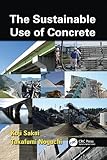The sustainable use of concrete [electronic resource] / Koji Sakai, Takafumi Noguchi.
Material type: TextPublication details: Boca Raton, Fla. : CRC Press, c2012Description: xi, 170 p. : illISBN: 9780203817179 (electronic bk.)Subject(s): Concrete | Concrete construction | Sustainable construction | Concrete -- Environmental aspectsGenre/Form: Electronic books.DDC classification: 624.1/834 LOC classification: TA439 | .S24 2012Online resources: Click to View Summary: "Preface The construction industry is very conservative. This can be seen as deriving from the special nature of its work which is creating the social and economic infrastructures required by each particular age in a "safe" way. Architecture is to some extent ahead of its time in the design of buildings but also reflects the inclinations of clients. In other words, the basic activity of the construction industry has been to reliably translate social needs into material form. Naturally, with the growing sophistication of requirements, construction technology has developed and many breakthroughs have been achieved to make the impossible possible, but this process has also been marked by many failures. The construction industry can be said to have built its technology systems through a process of "experience engineering." The construction industry exhibits a high degree of locality. Structures have generally been built by local people using local materials. Globalization has promoted internationalization in the construction industry as elsewhere, but the basics of construction systems have remained unchanged. What makes this possible is the wide use of concrete as a construction material. Its primary component materials are aggregate, cement, and water, with aggregate constituting approximately 70% of the total volume. The Earth's crust is composed of rocks that are the raw materials for aggregate. Water, when seawater is included, is the most commonly available globally circulating substance on Earth. In the case of cement, the raw materials are limestone and clay, both of which are also available in abundance"-- Provided by publisher.
TextPublication details: Boca Raton, Fla. : CRC Press, c2012Description: xi, 170 p. : illISBN: 9780203817179 (electronic bk.)Subject(s): Concrete | Concrete construction | Sustainable construction | Concrete -- Environmental aspectsGenre/Form: Electronic books.DDC classification: 624.1/834 LOC classification: TA439 | .S24 2012Online resources: Click to View Summary: "Preface The construction industry is very conservative. This can be seen as deriving from the special nature of its work which is creating the social and economic infrastructures required by each particular age in a "safe" way. Architecture is to some extent ahead of its time in the design of buildings but also reflects the inclinations of clients. In other words, the basic activity of the construction industry has been to reliably translate social needs into material form. Naturally, with the growing sophistication of requirements, construction technology has developed and many breakthroughs have been achieved to make the impossible possible, but this process has also been marked by many failures. The construction industry can be said to have built its technology systems through a process of "experience engineering." The construction industry exhibits a high degree of locality. Structures have generally been built by local people using local materials. Globalization has promoted internationalization in the construction industry as elsewhere, but the basics of construction systems have remained unchanged. What makes this possible is the wide use of concrete as a construction material. Its primary component materials are aggregate, cement, and water, with aggregate constituting approximately 70% of the total volume. The Earth's crust is composed of rocks that are the raw materials for aggregate. Water, when seawater is included, is the most commonly available globally circulating substance on Earth. In the case of cement, the raw materials are limestone and clay, both of which are also available in abundance"-- Provided by publisher.
Includes bibliographical references.
"Preface The construction industry is very conservative. This can be seen as deriving from the special nature of its work which is creating the social and economic infrastructures required by each particular age in a "safe" way. Architecture is to some extent ahead of its time in the design of buildings but also reflects the inclinations of clients. In other words, the basic activity of the construction industry has been to reliably translate social needs into material form. Naturally, with the growing sophistication of requirements, construction technology has developed and many breakthroughs have been achieved to make the impossible possible, but this process has also been marked by many failures. The construction industry can be said to have built its technology systems through a process of "experience engineering." The construction industry exhibits a high degree of locality. Structures have generally been built by local people using local materials. Globalization has promoted internationalization in the construction industry as elsewhere, but the basics of construction systems have remained unchanged. What makes this possible is the wide use of concrete as a construction material. Its primary component materials are aggregate, cement, and water, with aggregate constituting approximately 70% of the total volume. The Earth's crust is composed of rocks that are the raw materials for aggregate. Water, when seawater is included, is the most commonly available globally circulating substance on Earth. In the case of cement, the raw materials are limestone and clay, both of which are also available in abundance"-- Provided by publisher.
Electronic reproduction. Ann Arbor, MI : ProQuest, 2015. Available via World Wide Web. Access may be limited to ProQuest affiliated libraries.


There are no comments on this title.